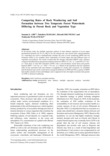Comparing Rates of Rock Weathering and Soil Formation between Two Temperate Forest Watersheds Differing in Parent Rock and Vegetation Type
Japan Agricultural Research Quarterly
| ISSN | 00213551 |
|---|---|
| NII recode ID (NCID) | AA0068709X |

Full text
jarq53-3_169-179.pdf1.21 MB
In the present study, the multiple regression analysis of mass balance equations of seven major geochemical elements (Al, Fe, Ca, Mg, K, Na, Si), among rock, soil, stream water, and precipitation in a watershed was used to simultaneously estimate the rates of rock weathering (RWR) and soil formation (SFR) in two template forest watersheds of Central Japan that had different types of vegetation and bedrock. Our results revealed that Mt. Kasuga watershed (MKW) with a primary evergreen broadleaf forest and gneissic bedrock had lower RWR (1.51 t ha−1 yr−1) and SFR (1.37 t ha−1 yr−1) than those in Yata Hill watershed (YHW) with a semi-deciduous mixed forest and granitic bedrock (RWR = 1.83 t ha−1 yr−1; SFR = 1.79 t ha−1 yr−1). Based on the hypothesis that the vegetation effect on the watershed scale mass balance is negligible in a steady state ecosystem, we concluded that the bedrock type can be a main factor causing the difference in RWR and SFR, as gneiss in MKW had smaller amounts of mica and feldspars and is supposed to have the higher resistance than granite in YHW to chemical weathering
| Date of issued | |
|---|---|
| Creator | Susumu S. ABE Takahiro HARADA Hiroshi OKUMURA Toshiyuki WAKATSUKI |
| Subject | geochemical mass balance multiple regression analysis watershed management |
| Publisher | Japan International Research Center for Agricultural Sciences |
| Received Date | 2018-02-05 |
| Accepted Date | 2018-10-22 |
| Volume | 53 |
| Issue | 3 |
| spage | 169 |
| epage | 179 |
| DOI | 10.6090/jarq.53.169 |
| Language | eng |
